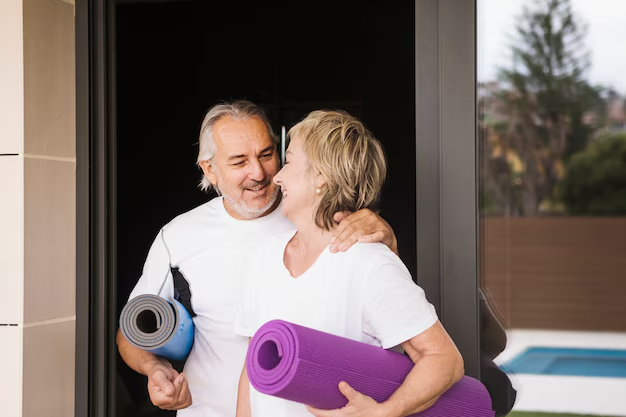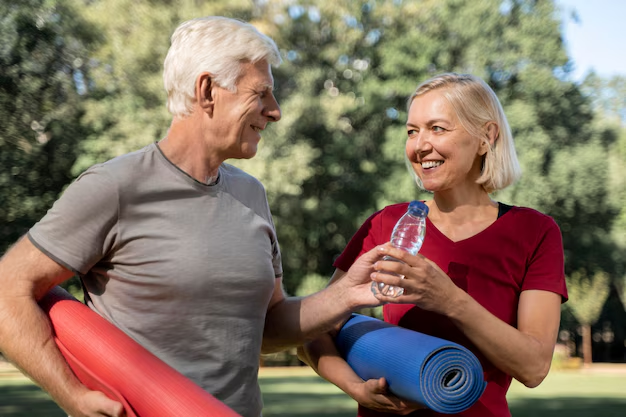Aging is a natural part of life, but it doesn’t mean we have to slow down or give up on staying active. In fact, maintaining an active lifestyle as you age is one of the best ways to preserve your health, independence, and quality of life. Regular physical activity can help prevent chronic diseases, improve mobility, enhance mood, and even prolong life. Whether you’re in your 50s, 60s, or beyond, it’s never too late to start—or continue—a fitness routine.
Tips for Staying Active as You Age The key to staying active as you age is understanding your body’s changing needs and making smart, safe choices. In this blog, we’ll explore a variety of tips to help you stay active, improve your fitness, and enhance your well-being as you grow older.
Start Slow and Progress Gradually
If you’ve been sedentary for some time or are just beginning to introduce exercise into your routine, it’s essential to start slow. Jumping into intense activities can lead to injuries, frustration, or burnout. Instead, ease into a workout routine and gradually increase the intensity over time.
- Begin with low-impact exercises like walking, swimming, or cycling. These activities are gentle on the joints and provide great cardiovascular benefits.
- Start with shorter sessions (10–15 minutes) and slowly build up to longer periods of activity. Aim for at least 30 minutes of moderate exercise most days of the week.
- Listen to your body and pay attention to any discomfort or fatigue. If something feels too challenging, it’s okay to scale back and work your way up at your own pace.
By progressing gradually, you’ll reduce the risk of injury and give your body the time it needs to adapt.
Include Strength Training
As we age, we naturally lose muscle mass, a condition known as sarcopenia. This can affect our balance, mobility, and overall strength, making everyday activities like climbing stairs or lifting groceries more challenging. Strength training can help counteract muscle loss and improve functional strength.
- Start with bodyweight exercises, such as squats, lunges, and push-ups, which can be done at home and without any equipment.
- Use light weights or resistance bands if you’re comfortable doing so. Begin with lighter loads and gradually increase the resistance as your strength improves.
- Focus on major muscle groups, including the legs, back, chest, and arms, with exercises that target these areas at least twice a week.
Strength training also promotes bone health by stimulating bone growth, which is especially important for preventing osteoporosis as we age.
Focus on Balance and Flexibility
Maintaining balance and flexibility becomes increasingly important as we age. Poor balance can lead to falls, which are a leading cause of injury in older adults. Flexibility is crucial for maintaining joint health and mobility. Incorporating exercises that improve both balance and flexibility can help you stay active and independent.
- Balance exercises: Standing on one leg, heel-to-toe walking, or practicing tai chi can help improve your stability and prevent falls.
- Stretching routines: Gentle stretching can increase flexibility and help keep muscles and joints limber. Focus on stretches that target the hips, hamstrings, back, and shoulders.
- Yoga and Pilates: Both of these practices focus on balance, flexibility, and core strength. They also help with posture and coordination, which are essential for preventing falls.
Aim to do balance and flexibility exercises two to three times a week to improve coordination and maintain a full range of motion.

Engage in Cardiovascular Exercise
Cardiovascular exercise is vital for maintaining heart health and overall endurance. As you age, it’s important to keep your heart and lungs strong to prevent diseases like high blood pressure, heart disease, and diabetes. Cardiovascular exercises also help with weight management and improve mood by boosting the production of endorphins.
- Walking: One of the simplest and most accessible forms of cardio exercise, walking can be done anywhere and is easy on the joints. Aim for brisk walking, which elevates the heart rate, for at least 30 minutes most days of the week.
- Swimming: Swimming is a low-impact, full-body workout that’s excellent for cardiovascular health. It’s gentle on the joints and can be a great option for older adults, especially those with arthritis or mobility issues.
- Cycling: Whether outdoors or on a stationary bike, cycling is an excellent low-impact activity that strengthens the heart and legs.
- Dancing: Whether it’s a fitness class, ballroom dancing, or just dancing at home, dancing is a fun and social way to get your heart pumping.
Aim for at least 150 minutes of moderate-intensity cardio each week, which can be broken up into smaller sessions if needed.
Listen to Your Body and Rest When Needed
As we age, recovery becomes just as important as the exercise itself. It’s crucial to give your body enough time to rest and recover between workouts to prevent overuse injuries. Pay attention to signs of fatigue or discomfort and adjust your routine accordingly.
- Take rest days: Schedule at least one or two rest days each week to allow your muscles to recover and rebuild.
- Sleep well: Quality sleep is essential for recovery and overall health. Aim for 7–9 hours of sleep each night to help your body repair itself.
- Watch for pain: While soreness is normal after a workout, persistent pain or discomfort could be a sign of an injury. If you experience joint or muscle pain, rest and seek medical advice if needed.
Taking proper care of your body through rest and recovery will help you stay active for the long term and prevent burnout.
Stay Consistent
The key to long-term fitness as you age is consistency. While it’s important to start slow, sticking to a regular routine is essential for seeing results and maintaining health. Consistent exercise helps prevent the decline of strength, balance, and flexibility, which are common challenges as we age.
- Create a schedule: Plan your workouts in advance and make them part of your daily routine. Consistency is more important than intensity, so prioritize regular movement over perfection.
- Set realistic goals: Whether it’s improving your walking speed, increasing the weight you lift, or simply staying active for a set amount of time each day, having specific goals will keep you motivated and on track.
- Track progress: Keep a journal or use a fitness app to monitor your progress. This will not only help you stay accountable but also show you how far you’ve come.
Staying active every day, even with small amounts of exercise, will have a lasting impact on your physical and mental well-being.
Join a Fitness Group or Class
Social interaction can be a great motivator to stay active. Joining a fitness group or class not only provides you with the opportunity to exercise in a structured environment but also gives you the chance to meet new people and stay engaged in a community. Group exercise can help keep you motivated and accountable.
- Fitness classes: Many community centers, gyms, and local organizations offer senior fitness classes such as chair yoga, water aerobics, or gentle strength training. These classes are designed to accommodate different fitness levels and offer expert guidance.
- Walking or running groups: Many communities have walking or running groups that meet regularly. These groups are perfect for those who prefer to exercise with others and can help you stick to a consistent routine.
- Online communities: If attending in-person classes isn’t an option, consider joining virtual fitness groups. Many fitness platforms offer online classes and virtual support groups tailored to older adults.
Social exercise not only enhances physical fitness but also supports emotional well-being and combat isolation.

Focus on Enjoyment
Lastly, the best way to stay active as you age is to engage in activities you truly enjoy. Exercise doesn’t have to be a chore. If you find an activity that makes you happy, you’re more likely to stick with it.
- Explore different activities: Try a variety of exercises, such as hiking, gardening, playing tennis, or doing home workouts, to see what you enjoy most.
- Incorporate fun: Choose activities that bring you joy, whether it’s dancing to your favorite music, walking in nature, or playing with grandchildren.
- Stay flexible: Be open to trying new things, whether it’s a new class, outdoor adventure, or fitness trend.
Enjoying your exercise routine makes it easier to stay motivated and active, even as you age.
Conclusion
Staying active as you age is one of the best ways to ensure good health, maintain independence, and enjoy a high quality of life. By incorporating strength training, cardio exercises, balance activities, and stretching into your routine, you can preserve your mobility, reduce the risk of chronic diseases, and enhance your overall well-being.
Remember, it’s important to start slow, listen to your body, and remain consistent. Exercise should be something you look forward to, not something you dread. By finding activities that you enjoy and engaging in them regularly, you can stay active and healthy for many years to come.

